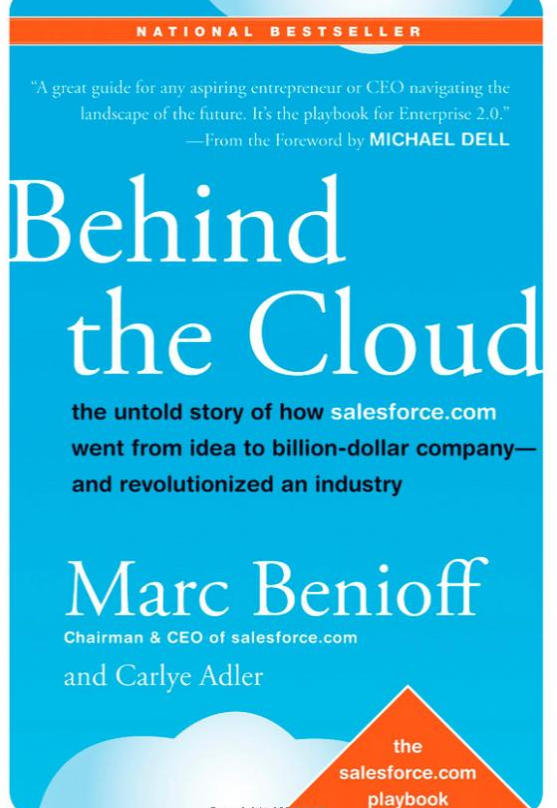I’m on a SaaS/Enterprise software kick lately. Mostly from a process of elimination: if you understand consumer web pretty well, but suspect that the good ideas will mostly be implemented or perhaps murdered by the market leaders, what’s the closest adjacent market? It helps that as a white collar worker, I’m an avid connoisseur of good and bad enterprise software — the contrast between software that’s chosen by users and software that’s sold to somebody who won’t have to deal with it is just inescapable.
Since consumer-facing companies have a high name recognition to market value ratio, there are lots of books about the sector; there aren’t nearly as many about SaaS. The one book everyone recommends is Marc Benioff’s Behind the Cloud. The book was published in 2009, but it’s not dated; time moves more slowly in enterprise land.

My SaaS thesis is that many lessons learned in the hothouse environment of consumer web can be copied over to SaaS with little loss of generality. Not everything copied over — a lot of consumer web math works when costs are zero. On the other hand, the next best thing to zero cost is a nonzero cost paid for by somebody else, so the subset of enterprise software products that can be put on a corporate card, rather than bought via RFP, should be fertile ground for this kind of thinking.
Behind the Cloud bears this thesis out. The book is full of original ideas that were actually somebody else’s original idea:
- Salesforce took a piece of clunky desktop software, and made a version that anyone could access — from their browser! — in 1995! Wait, no, that was Viaweb. But Salesforce did it in 2000, which is close.
- Early in Salesforce’s life, in 2000, Benioff hired the B-52s to play at their launch party. I don’t know where he got the highly original idea of promoting software by writing a giant check to a famous band.
- At one point, to emphasize something about how warlike the competitive environment was, he donned camouflage. Just like Southwest Airlines’ CEO did a couple years before. (There’s no Salesforce photo op, at least none I could find).
- Benioff runs an ad campaign where Salesforce is represented as a jet, shooting down a biplane. In this case, he’s borrowing with explicit permission, and says so: the campaign was previously used by Oracle, where Benioff worked before founding Salesforce.
There’s nothing wrong with borrowing ideas from different fields and applying them to your own. That’s most of what I do. It’s inspiring, actually: it means that SaaS as an industry combines a long growth runway with a fairly well-defined path forward: figure out something that worked in consumer, determine whether or not it depends on user accounts costing $0, and, if not, implement.
Timing the Narrative
There are some parts of the book that illustrate something important about timing and narratives. At one point, Salesforce.com finds out that Siebel, a competitor, is hosting a conference in Cannes. So, salesforce 1) rents every single taxi at the Nice airport, and 2) has their salespeople sit in the backseat and pitch to Siebel customers the whole trip to Cannes. Whether this story is charming or sinister depends entirely on scale: if you like schemes like these, be sure to get them out of your system while you’re still an underdog.
In a fun throwback to Trust Me, I’m Lying, Benioff says one way to promote his company is to “leak” internal memos (quotation marks his). That’s also a technique that probably doesn’t work so well at scale, where “Industry leader tries to manipulate media” is a bigger story than hot gossip about a hot industry.
The flip from scrappy underdog to overdog must be a hard one to navigate: surely every founder is keenly aware of the risks they face, so they feel threatened long after they’re in the clear. Oddly, I can’t think of any company that failed specifically because they didn’t manage this transition, but it probably happened to somebody.
Eternal Truths
It’s interesting to look at which parts of the book held up well, which held up poorly, and which turn out to illustrate deeper truths:
- Technical comments age poorly, as one would expect. Benioff notes that even when customers were complaining about frequent downtime, Salesforce’s uptime was always at least 99%. But 99% uptime means three and a half days of downtime a year, for a product people use to do business! Uptime standards keep getting higher; even for free products, ten minutes of downtime is newsworthy. Later, he says that developers like working at web-based software companies because their code can be live in three to six months. Imagine! Being stuck with whatever product decisions made sense three whole months ago.
- California Real Estate: he complains about scarce California real estate in the early 2000s. Ah, if only you knew.
- The mechanics of selling: one striking little detail about Salesforce’s global expansion was the fact that they didn’t need international offices as early as some of their competitors did: with an on-premise product, you need your clients to physically go to your office to see a demo, so not only do you need local offices, but they need to be in expensive parts of town. Since Salesforce is web-based, they saved money on London rents. This raises an interesting point: if the desktop-to-mobile transition is still happening in enterprise, it will reshape sales the same way: you don’t even need to sell to someone at their office, as long as one of you has a phone. Your elevator pitch can literally happen in the elevator.
- SaaS Math: “We quickly discovered that the more salespeople we hired, the more we saw revenue increase.” Part of the reason I avoided learning about enterprise software is that I’m personally averse to sales. I really prefer business models that minimize eye contact. But what was true in 2000 is still true today: once you’ve got your product figured out, if you’re selling it to businesses for money, your main avenue for sales growth is salespeople. It seems like every successful SaaS company looks like it’s overstaffed on sales, but if that’s the instinct it must be exactly wrong: if everyone’s averaging between analysis and gut feel, and gut feel says to hire fewer salespeople, then they’re underhiring.
You can tell two stories about technology companies: a pure technology story, where someone invents a better product, and a social/political one, where someone finds a way around traditional gatekeepers. Most successful tech companies are some combination of the two — or at least they scale up with one until the other is the limiting factor. The increasing maturity of the consumer web actually pushes both narratives: it’s harder to break into consumer-facing Internet, because the last round of winners now control distribution. At the same time, there’s a “peace dividend” in the form of technology stacks and growth marketing techniques that can be easily repurposed. For the next couple years, SaaS is where it’s at.

 Byrne Hobart
Byrne Hobart